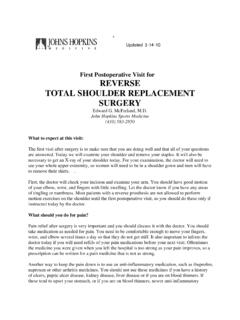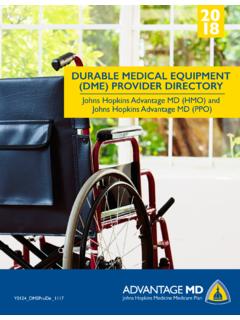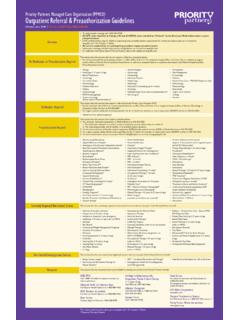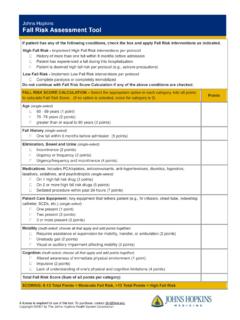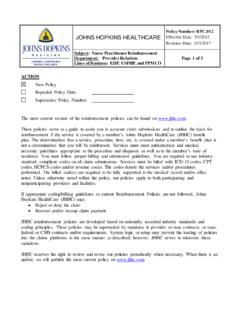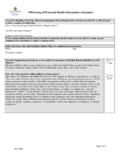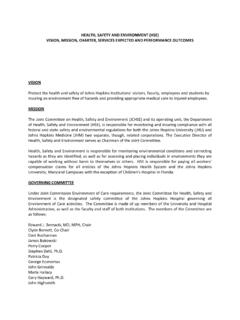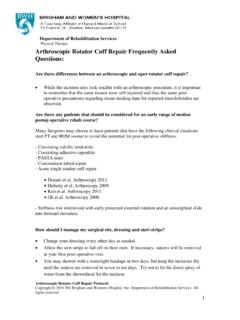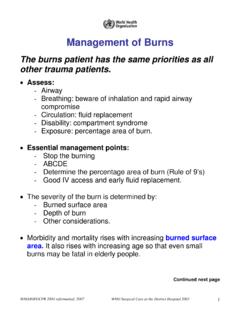Transcription of PATIENT GUIDE TO INTERPRETING YOUR SHOULDER MRI
1 PATIENT GUIDE TO INTERPRETING your SHOULDER MRI Edward G McFarland MD Jacob Joseph BA Kyubo Choi Why this GUIDE to MRI of the SHOULDER ? We are writing this GUIDE to help patients understand the MRI report which they often get from the radiologist. We have found that these reports are confusing for patients as the MRI often lists many things which may or may not have anything to do with the PATIENT s symptoms or problem. We have created this GUIDE to reassure them that many of the findings on the MRI reported by the radiologist are just things people get as they get older and may not be anything to worry about.
2 However, any findings that are of a concern to you should be discussed with your doctor. This GUIDE is not intended as a substitute for you speaking with your doctor. What exactly is an MRI? MRI stands for Magnetic Resonance Imaging and is a type of radiology evaluation which does not involve radiation like plain x-rays and computed tomography (CT scans). An MRI consists of a large circular magnet which creates images of the tissues in the body without radiation. While plain x-rays show bones very well (Figure 1), MRI shows the soft tissue around the bones and joints (Figure 2).
3 The bones in your body meet at joints where they are held together by tough tissues called ligaments which run from one bone to another. The joint also has muscles around it which when they contract or squeeze to make the bone move. The muscles attach to the bone via tendons which are specialized to attach the muscle to bone. In the SHOULDER there are many muscles around the joint but the ones of interest are the rotator cuff. These are a set of muscles which start on the SHOULDER blade but attach to the arm bone (the humerus) by tendons (see PATIENT GUIDE to Rotator Cuff Tendinitis).
4 The rotator cuff tendons are fairly thick tendons (about as thick as your little finger) and wide (each one about as wide as three of your fingers). There is one rotator cuff tendon in the front of the SHOULDER (the subscapularis), one on the top (the supraspinatus) and two in the back of the SHOULDER (the infraspinatus and the teres minor). These tendons as they attach to the humerus to form a cuff of tendons. As opposed to plain x-rays, MRI can let you see the rotator cuff muscles and tendons whereas x-rays cannot.
5 Why would I need an MRI? For many SHOULDER conditions the diagnosis of what is wrong with your SHOULDER can be made with a good history and examination of the SHOULDER . The first test which should be done by your provider to assess SHOULDER problems is a plain X-ray of your SHOULDER . We recommend regular radiographs be obtained and evaluated before an MRI is ordered. While occasionally some physicians order an MRI before obtaining regular x-rays, it is good practice to first get a regular x-rays as they are good for detecting fractures, arthritis or abnormal bones in the SHOULDER .
6 A complete evaluation of your SHOULDER should include regular x-rays and not just an MRI. Figure 1. The example of SHOULDER plain x-ray shows bones very well. Figure 2. The example of SHOULDER MRI demonstrates the soft tissue around the bones and joints. Acromion Glenoid Head of Humerus Shaft of Humerus Rotator cuff muscle Deltoid muscle How does the radiologist read the MRI? The radiologist gets the scan on the computer and the MRI images show them different parts of the SHOULDER in slices. In other words, the scan is like cutting cheese in that they do not see the whole block but rather see only slices.
7 These slices can be made to see structures from the front, the side or from the top. Each slice will show parts of the SHOULDER but no one slice tells the whole story. As a result, the images that the radiologist sees on the screen have to be put together in their minds to come up with an idea of what is normal and what is not. This of course takes a lot of training and SHOULDER MRI is known as being particularly difficult to read by radiologists. The reason for this is that the tendons and other soft tissue in the SHOULDER joint are complex, so not many slices cut through the structures more than a couple times.
8 Fortunately the MRI scan can make images from different angles which gives more information to the radiologist. The radiologist looks at the images in the scan and then they describe what they see on the scan. How does the radiologist know what is causing my problem or my symptoms? The radiologist will look at all the structures in your SHOULDER MRI and describe what they see. The radiologist cannot tell if what they see is causing your symptoms or not. As a result, just because the radiologist sees some changes on your MRI it does not mean that those changes are the cause of your pain or your symptoms.
9 The radiologist is obligated to describe what they see, so often they will comment in the report that clinical correlation is recommended. This means that while they see the abnormality, the doctor examining and treating you has to determine if what they see is actually the cause of your problem. This is where reading the MRI report of your SHOULDER gets tricky. The report has to record any abnormality whether it is important or not, so many SHOULDER MRI reports sound as if your arm is going to fall off. It is important to realize that the radiologist is only reporting what he sees on the film and to not get concerned about every finding.
10 Also often the radiologist is not one hundred percent sure of what they see as they are only seeing certain slices of the SHOULDER joint. As a result, they will often report possible lesion or possible tear or probable tear. Whether or not the changes are important should be discussed with your physician. Lastly, another issue with an MRI is that many structures in your SHOULDER change as you get more mature. These changes can be seen in your MRI. While these changes are no longer normal, they may be normal for your age.
